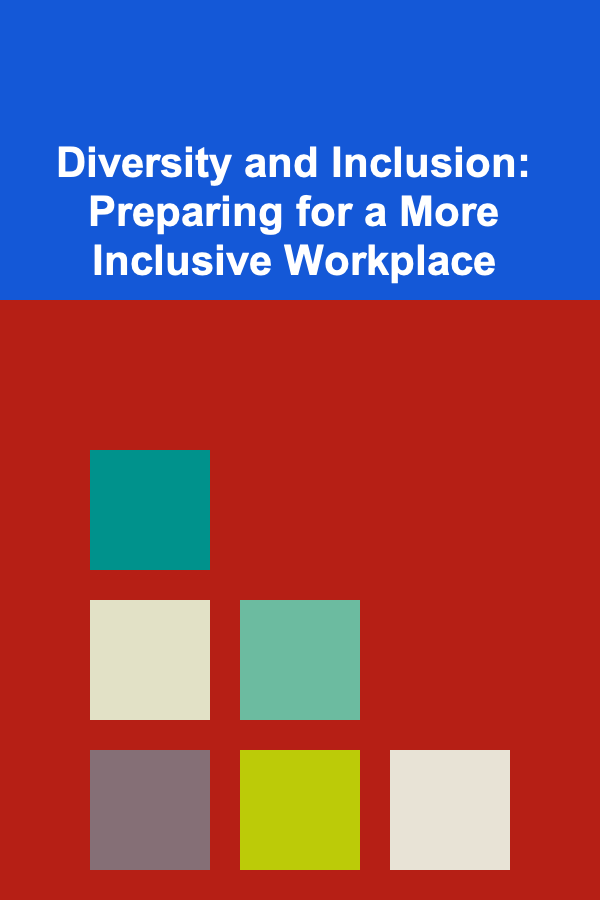
Diversity and Inclusion: Preparing for a More Inclusive Workplace
ebook include PDF & Audio bundle (Micro Guide)
$12.99$9.99
Limited Time Offer! Order within the next:

In today's rapidly evolving world, creating a diverse and inclusive workplace is no longer just a trend---it's a necessity for organizations seeking long-term success. Companies that embrace diversity and inclusion (D&I) benefit from increased innovation, higher employee satisfaction, and improved overall performance. However, building an inclusive workplace is not a one-time effort. It requires consistent planning, action, and a commitment to creating an environment where every individual feels valued, heard, and respected.
This guide delves into the essential steps for preparing for a more inclusive workplace, focusing on actionable strategies for fostering diversity, equity, and inclusion (DEI) within organizations.
Understanding Diversity and Inclusion
Before diving into the actions needed to create a more inclusive workplace, it's crucial to define what diversity and inclusion mean.
- Diversity refers to the presence of differences within a given setting. These differences can encompass a wide range of characteristics, including race, gender, sexual orientation, age, religion, disability, socioeconomic background, education, and more. Diversity is about having a variety of perspectives, experiences, and identities in the workplace.
- Inclusion goes beyond just bringing diverse people together. It involves creating a culture where all individuals feel valued, respected, and empowered to contribute their unique perspectives. Inclusion is about ensuring that all voices are heard and that every employee has equal opportunities to thrive.
Assessing Your Current Workplace Culture
The first step in preparing for a more inclusive workplace is to assess where your organization currently stands. It's essential to understand your starting point in order to effectively create a roadmap for improvement.
A. Conduct a Diversity Audit
A diversity audit helps identify the current demographics within your organization, as well as gaps in diversity. You can gather data on race, gender, sexual orientation, and other factors to see if your organization reflects the diversity of the community or industry in which you operate. However, it's important to go beyond just counting heads---an audit should also assess how inclusive the workplace is and whether all employees feel respected.
B. Collect Employee Feedback
Employee feedback is invaluable when assessing your current workplace culture. Anonymous surveys or focus groups can be used to gather insights on employees' experiences related to inclusion. Questions to ask might include:
- Do you feel valued in the workplace?
- Have you ever experienced bias or discrimination at work?
- Do you believe your organization provides equal opportunities for growth and development?
By collecting and analyzing this feedback, you can gain a clearer understanding of areas that need attention and improvement.
Setting Clear and Actionable D&I Goals
Once you've assessed your current workplace culture, it's time to set clear, measurable goals for your diversity and inclusion efforts. These goals should be specific, achievable, and aligned with your organization's overall mission and values.
A. Define Success Metrics
To track your progress, establish key performance indicators (KPIs) for diversity and inclusion. Examples of such metrics might include:
- Workforce diversity: Percentage of employees from diverse racial, ethnic, and gender backgrounds.
- Leadership diversity: Percentage of underrepresented groups in senior leadership positions.
- Employee engagement: Results from employee surveys measuring inclusion and sense of belonging.
- Retention rates: Tracking whether diverse employees are staying with the organization or leaving at higher rates than others.
These metrics help ensure that your efforts are focused and measurable, and they provide a clear benchmark for success.
B. Set Both Short-Term and Long-Term Goals
Diversity and inclusion efforts are ongoing. Set both short-term and long-term goals to ensure your organization is making continuous progress. Short-term goals might include launching unconscious bias training, while long-term goals could involve creating a diverse leadership pipeline.
Fostering Inclusive Leadership
Inclusive leadership is crucial in shaping an environment where diversity thrives. Leaders must not only endorse diversity and inclusion but also lead by example and actively contribute to creating an inclusive culture.
A. Develop Inclusive Leadership Skills
Leaders should be trained on how to foster an inclusive workplace by developing key inclusive leadership skills, such as:
- Empathy: Understanding and sharing the feelings of others.
- Cultural competence: Ability to interact effectively with people from different cultural backgrounds.
- Active listening: Giving everyone a voice and listening to understand, not just to respond.
- Accountability: Holding themselves and others accountable for fostering inclusion and equity.
Training and development programs can be tailored to help leaders understand the importance of diversity and inclusion, as well as teach them how to lead inclusive teams.
B. Encourage Open Conversations About D&I
Leaders must create a safe space where employees can openly discuss issues related to diversity and inclusion. This can include facilitating open forums, panel discussions, or team meetings where employees are encouraged to share their experiences, ask questions, and discuss their perspectives.
Building an Inclusive Recruitment Process
Recruiting diverse talent is one of the most direct ways to increase diversity in the workplace. However, to be truly inclusive, your recruitment process must be free from biases and barriers that could disadvantage certain groups.
A. Evaluate Job Descriptions for Bias
Job descriptions should be carefully crafted to avoid gendered language, unnecessary requirements, or terminology that may alienate potential candidates. Use gender-neutral language and focus on essential skills and experience rather than qualifications that may disproportionately disadvantage certain groups.
B. Diversify Sourcing Channels
Relying on the same traditional recruitment channels can limit the diversity of your candidate pool. To ensure a more diverse range of applicants, consider sourcing candidates from:
- Community organizations: Partner with local organizations that support underrepresented groups in the workforce.
- Job boards for diverse candidates: Use job platforms like DiversityJobs, Black Career Network, or Women for Women to target diverse job seekers.
- University outreach: Build relationships with universities and colleges with diverse student bodies.
C. Implement Blind Hiring Practices
Blind hiring removes demographic information (such as names, photos, and schools) from resumes to reduce unconscious bias. This allows hiring managers to evaluate candidates based purely on their qualifications and experience, helping to create a more equitable recruitment process.
Creating an Inclusive Workplace Culture
Diversity without inclusion doesn't lead to the full benefits of a diverse workforce. To retain diverse talent and ensure that all employees feel comfortable, engaged, and respected, it's essential to cultivate an inclusive workplace culture.
A. Encourage Employee Resource Groups (ERGs)
Employee Resource Groups (ERGs) are voluntary, employee-led groups that aim to foster a more inclusive environment by providing support, advocacy, and a sense of community for underrepresented groups. ERGs help raise awareness of different perspectives, create networking opportunities, and provide feedback to leadership on how to improve the workplace for everyone.
B. Implement Flexible Work Policies
Inclusion extends beyond the office environment. Flexible work policies, such as remote work, flexible hours, and paid parental leave, can help employees from diverse backgrounds, especially those with caregiving responsibilities, balance work and personal life.
C. Promote Mental Health and Well-Being
An inclusive workplace must also consider the mental health and well-being of its employees. Organizations can support employees by offering resources such as counseling services, stress management programs, and workshops that focus on building resilience and emotional intelligence.
Ongoing Education and Training
To sustain an inclusive workplace, ongoing education and training are essential. This can include mandatory diversity training, but it should also go beyond one-time events. A commitment to continuous learning and development is key to keeping the workplace inclusive over time.
A. Provide Unconscious Bias Training
Unconscious bias can subtly influence decisions regarding hiring, promotions, and everyday interactions. Offering unconscious bias training can help employees identify and challenge their own biases, ensuring that all individuals are treated equitably.
B. Foster a Growth Mindset
Encourage employees at all levels to adopt a growth mindset by promoting continuous learning. This can involve providing opportunities for skill development, attending workshops, or offering mentorship programs. The goal is to create a culture of growth where everyone, regardless of background, feels they have the opportunity to succeed.
Measuring Progress and Adjusting Strategies
Building a truly inclusive workplace is a long-term commitment, and progress should be measured regularly. Periodically assess your diversity and inclusion initiatives to ensure they are effective and relevant.
A. Monitor and Track Key Metrics
Regularly review the diversity and inclusion metrics you established earlier. Tracking your progress ensures you stay on course and can identify areas for improvement.
B. Adjust Based on Feedback
Listen to employee feedback and be open to adjusting strategies. If certain initiatives are not having the desired impact, be flexible and willing to try new approaches.
Conclusion
Preparing for a more inclusive workplace is a journey that requires consistent effort and a commitment to change. By understanding the importance of diversity and inclusion, assessing your current culture, setting actionable goals, and creating an inclusive environment, you can create a workplace where all employees feel valued and empowered. In turn, this will lead to better innovation, employee engagement, and organizational success. Diversity and inclusion are not just buzzwords---they are key drivers of growth and success in the modern workplace.

How to Build a Successful Pet Supplies Store with Minimal Investment
Read More
How to Build Strong Communication Channels with Your Virtual Assistant in Dropshipping
Read More
How to Create a Decluttering Routine That Sticks
Read More
How to Foster a Culture of Organization in the Workplace
Read More
How to Set Up a Family Command Center in Your Entryway
Read MoreHow to Understand AR Tracking Technologies
Read MoreOther Products

How to Build a Successful Pet Supplies Store with Minimal Investment
Read More
How to Build Strong Communication Channels with Your Virtual Assistant in Dropshipping
Read More
How to Create a Decluttering Routine That Sticks
Read More
How to Foster a Culture of Organization in the Workplace
Read More